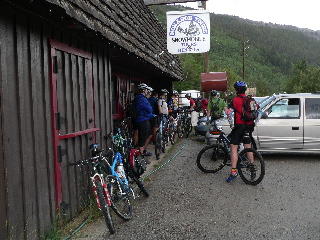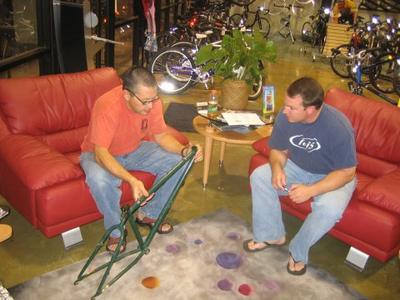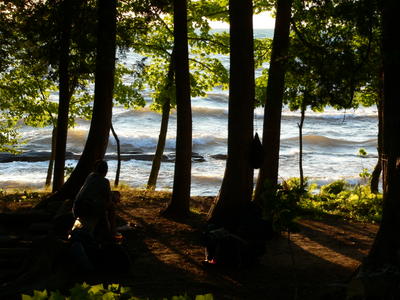Gateway Off-Road Cyclists
Remember a few years ago when that bunk doctor published that BS about cycling causing impotency firing off a frenzy of ignorance about your nads and their placement? Well, just when you thought it was a good idea to not get all sweaty riding bicycles and stay on the couch to read this blog we get this:
Wired News
Laptops Are Hot; Maybe Too Hot
By Bruce Gain
Story location: http://www.wired.com/news/infostructure/0,1377,68163,00.html
02:00 AM Jul. 13, 2005 PT
It may be hard to fry an egg on a new laptop today, but notebook surface temperatures remain too hot for many users -- and the situation could get worse.
Contemporary laptops are generally cooler than their predecessors. In IBM's case, what it calls the maximum "skin temperature," or surface temperature, is 45 degrees Celsius (113 Fahrenheit), which is considered an optimal threshold in the industry. However, laptop makers increasingly struggle to accommodate components that are more powerful and, consequently, hotter.
After dropping for a few years, CPU temperatures are "ticking back up" as customers seek faster, higher-power-generating laptops, said Jeff Lev, a mechanical-development engineer for the commercial portable sector of HP's personal-systems group.
Laptop temperatures also got more negative attention in December when researchers from the State University of New York at Stony Brook published a study in the journal Human Reproduction. The study showed a decrease in fertility among test subjects when laptops caused an increase of up to 2.8 degrees Celsius in the "scrotal temperatures" of 29 healthy male subjects.
Laptop temperatures are generally lower compared to five years ago, when CPU temperatures were largely left unchecked. Then, the higher wattages and heat outputs of faster notebook processors began to make battery lives and surface temperatures unviable for many manufacturers -- and users.
"Finally, (Intel) came around and said, 'OK, you guys are right: We want to increase performance but keep the power down,'" said Howard Locker, chief architect for desktop and mobile development at Lenovo for IBM.
Meanwhile, the CPU is not the only guilty party when it comes to notebook heat levels. Other power-hungry components, such as hard disks, memory modules and especially graphics processors -- with clock speeds now surpassing 500 MHz -- add to the heat-factor equation.
"Graphics is one of the things we see in the future that we are going to pay attention to so that we don't concentrate on the CPU and then have the problems we had five years ago all over again," HP's Lev said.
Laptop makers who spoke with Wired News generally did not predict that notebooks will become a lot cooler any time soon. However, they indicated that they will continue to spend plenty of R&D dollars on heat-management designs so surface temperatures of next-generation systems at least do not increase.
"The speed, then the heat, goes up, so we spend a lot of upfront time doing computation work (involving) fluid dynamics where we put in a bunch of scenarios in the computer and let it spit out solutions," Lev said.
For laptop makers, design challenges largely involve removing and distributing heat from concentrated areas, such as around the CPU chipset. Heat buildup in one spot can make a laptop too hot to touch in specific surface areas. Moreover, after certain temperature thresholds are surpassed, system components become unstable.
Laptops largely rely on heat pipes that use liquid coolants to cool and distribute heat away from the chipset. Fans also keep temperatures down, albeit on a smaller scale compared to desktops. However, the resulting designs see varying degrees of success.
"In some rare instances they do a really good job -- the larger the laptop the easier this is," said Rob Enderle, principal analyst for the Enderle Group. "But often either the bottom, the keyboard or the wrist rest become uncomfortably hot even with the latest processors."
On a CPU level, power is measured by thermal design power, or TDP, watts, which represent what Advanced Micro Devices and Intel say are the maximum values that system builders must accommodate. AMD's mobile Athlon 64 and Intel's latest Pentium M mobile CPUs keep the TDP down by regulating power according to the application being used.
CPU power-saving tweaks for notebooks have existed for some time. However, compared to models from years past, the latest generation of processors from AMD, Intel and Taiwanese CPU maker Via manage to gauge and shut down CPU clock cycles more efficiently when power is not needed.
AMD and Intel offer services called PowerNow and SpeedStep, respectively, which regulate multiple processor clock speeds and reduce speeds according to the computing task. This reduces overall TDP values, which both lowers heat levels and helps to save battery life.
"We are going to continue to go down this path to lower power," said Dave Everitt, European products and platforms manager for AMD. The company's Turion 64 products, for example, are designed to offer a TDP of 35 watts or 25 watts, Everitt said. A few years ago it would have been something like 60 watts.
Additionally, laptop PC makers have designed more intelligent BIOS software that is able to reduce screen brightness, a significant generator of heat and a drain on battery power.
"Our argument is that the hardware in a laptop is more than you need most of the time," Locker said. "If we can do intelligent throttling, or pulling back performance, then that is a good thing, because it makes your battery last longer and makes the notebook cooler."
When dual-core AMD and Intel x86 PC processor architectures become widely incorporated in notebooks next year, the move won't necessarily increase thermal output per processor, the chipmakers say.
"You might think that by doubling the core, you are then doubling the thermal output, but in fact it will remain approximately the same," said Mike Trainor, chief mobile technology evangelist for Intel. "There is a lot of engineering that puts together circuitry to make sure that for each core the thermal output will go up or down as needed by the software load."
It is usually the thinner and lighter notebooks for which heat is more of a concern. Smaller notebooks also pose the most difficult design challenges for PC makers, since there is less space for airflow and heat dissipation.
"Every time we have a market for a smaller notebook with added performance, that is when you have to stop and take a breath and ask: 'Can we really do this?'" HP's Lev said. "And there have been situations where we said, 'We really don't know if this is the best thing for us.'"
End of story. Now go ride and feel the burn, or teabag the closest person that passed out too early...







 your 2005 Singlespeed World Champ.
your 2005 Singlespeed World Champ.









